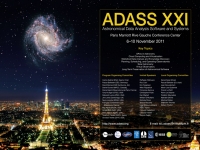Michael Sherry (NUI Galway), Andy Shearer (NUI Galway)
Abstract
The initial success of the IMPAIR software in the areas of radiology, optical astronomy and gamma-ray astronomy image restoration problems was in part limited by the scale of the distributed computing resources available for image processing. The demands of the number of iterations required to achieve acceptable deconvolution, accommodating for the spatially variant PSF, and the resource requirements of the Fourier and wavelet transforms meant the technique was only practical to those with access to specialised systems. Over the last five years this ceiling has been lifted with the introduction of heterogeneous computing environments, such as the GPU, which allow access to hundreds of specialised computational cores and gigabytes of memory from a single workstation with negligible latency. What follows is a report on the on-going process of porting the original IMPAIR software to the NVIDIA Tesla computing platform. Implementations of the lifting and filter based approaches to the wavelet transform in both CUDA code and as a set of calls to the CUBLAS library are compared. Initial results from the application of the software towards improving the relative spatial location of point sources in gamma-ray images from the Fermi satellite are presented.Paper ID: P139
Poster Instructions
|

